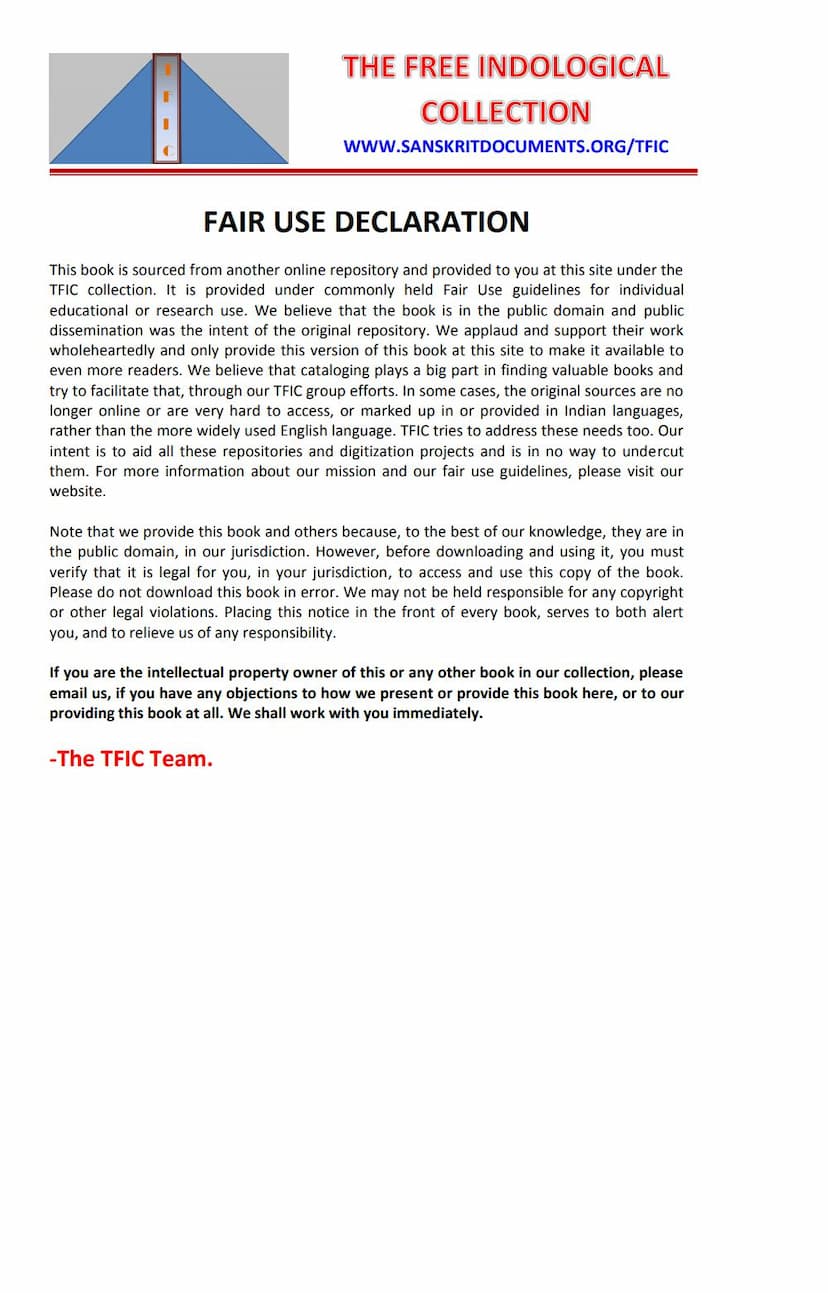Tattvartha Raj Varttikalankara
Added to library: September 2, 2025

Summary
This is a summary of the Jain text "Tattvartha Raj Varttikalankara" by Gajadharlal Jain and Makkhanlal Shastri, published by Bharatiya Jain Siddhant Prakashini Sanstha. The text is a commentary on the Tattvartha Sutra.
Book Title: Tattvartha Raj Varttikalankara Author(s): Gajadharlal Jain, Makkhanlal Shastri Publisher: Bharatiya Jain Siddhant Prakashini Sanstha
The provided text is an excerpt from this book, specifically focusing on the initial chapters and providing context about its publication and the importance of the work. Here's a breakdown of the key aspects:
Publication Details:
- The book is part of the "Gandhi-Haribhai Devkaran Jain Granthamala."
- It is published by Bharatiya Jain Siddhant Prakashini Sanstha, Calcutta.
- The Hindi translation was done by Pt. Gajadharalalji Nyayateerth and revised/enlarged by Pt. Makkhanlalji Nyayalamkar Vadikeshri.
- The publication was made possible through a donation from Gandhi-Haribhai Devkaran & Sons of Sholapur.
- The original Sanskrit text was published earlier in Varanasi by the same institution in Veer Nirvana Samvat 2441 (1615 AD).
Content Overview (Based on the provided excerpt):
-
Mangalacharan (Opening Invocation): The text begins with traditional Jain invocations, paying respects to Siddhas, Omkara, and Goddess Saraswati, and invoking auspiciousness for Lord Mahavir, Gautam Swami, Kundakundacharya, and the Jain Dharma.
-
Introduction to Tattvartha Raj Varttikalankara:
- It is described as a commentary (Varttika) on the Tattvartha Sutra by Acharya Bhatta-kalanka-deva.
- The original text is in Sanskrit, considered to be of 16,000 shloka (verse) magnitude.
- It aims to explain the Tattvartha Sutra using simple Sanskrit, refuting other philosophical systems, and establishing Jain principles with logical arguments.
- The text is noted for its comprehensiveness and depth, leading to a profound understanding of Jain principles for its readers.
-
Author Introduction (Acharya Bhatta-kalanka-deva):
- The Varttika is based on the Tattvartha Sutra, authored by Acharya Umaswami (also known as Varna-datta). The original Tattvartha Sutra itself has 10 chapters and 357 sutras, but its commentaries, like the Varttika, can be vast, reaching up to 84,000 shlokas.
- From an inscription within the Tattvartha Raj Varttikalankara itself, it is inferred that Acharya Akalankadeva (presumably the author of the original Varttika or a key figure in its lineage) was the son of King Laghuvindhra and was highly renowned among scholars of his time.
- His other famous works include Ashtashati, Nyaya Vinishchayalamkara, Laghu-trayee, and Brihad-trayee.
- Acharya Akalankadeva is credited with significantly promoting Jainism and weakening the influence of Buddhism in India. His writings were crucial in defending the purity of Jain teachings.
- He is also known for defeating a Tara goddess worshipped by Buddhists, which led to a significant propagation of Jainism.
-
Structure and Publication:
- Due to its vastness and the expense involved, the book has been published in six volumes, totaling approximately 2500 pages.
- The names of the authors (translators/editors) are mentioned at the end of each chapter.
- The publisher acknowledges potential inaccuracies due to human error and requests readers to inform them of any mistakes for correction.
-
Content Focus (Initial Pages):
- The initial pages delve into the definition and necessity of Samyak Darshan (Right Faith), Samyak Jnana (Right Knowledge), and Samyak Charitra (Right Conduct) as the path to liberation (Moksha).
- It discusses the philosophical disagreements between various Indian schools (like Sankhya, Mimamsa, Vedanta, Bauddha, Nayayika, Vaisheshika) regarding the nature of reality, the soul, liberation, and the means to achieve it.
- The text emphasizes the Jain perspective on these topics, often contrasting it with other philosophical views.
- There's a detailed breakdown and explanation of the core Jain principles like Jiva (soul), Ajiva (non-soul), Asrava (influx of karmas), Bandha (bondage), Samvara (stoppage of karmas), Nirjara (shedding of karmas), and Moksha (liberation).
- The commentary provides detailed etymological and philosophical explanations of key terms and concepts within Jainism, using grammatical rules (vyutpatti) and logical reasoning (yukti).
- The importance of Nayas (standpoints or modes of approach to reality) like Dravyarthika and Paryayarthika is highlighted, along with other subordinate Nayas (e.g., Naigama, Sangraha, Vyavahara, Rujusutra, Shabda, Abhihita-arth, Evam-bhuta).
- The nature of knowledge (Jnana) is discussed, differentiating between Mati, Shruta, Avadhi, Manahparyaya, and Kevala knowledge, and their respective causes and characteristics.
- The text also touches upon the concept of karma, its modes of manifestation, and their impact on the soul's journey.
Overall Significance:
The Tattvartha Raj Varttikalankara, as presented in this excerpt, is a monumental work in Jain literature, aiming to provide a deep and reasoned explanation of Jain philosophy, particularly the path to liberation. It engages with and refutes opposing philosophical viewpoints, establishing the superiority of the Jain perspective through meticulous analysis and scriptural evidence. The translation into Hindi by esteemed scholars makes this profound text accessible to a wider audience.